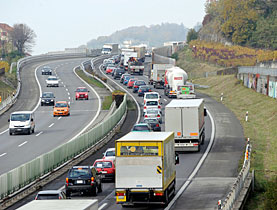
Lake Geneva region faces transport gridlock

Packed trains, heavy motorway traffic and a saturated international airport. The booming Lake Geneva region is straining under the weight of its own success.
This week the Conseil du Léman cross-border organisation presented a proposal for a coordinated regional transport solution, which outlines the most pressing needs of the region.
The Lake Geneva region is undergoing an unprecedented business boom. Over the past ten years it has managed to register consistently above-average growth, attracting new companies and residents.
Over this period, the population of cantons Vaud and Geneva has grown by 100,000 (up ten per cent) and an additional 200,000 people are expected to move to the Swiss side by 2025.
But the flipside is that north of the lake, “both the road and rail networks (150,000 movements per day) are saturated during rush hour”, says the Conseil du Léman, which represents the Swiss cantons Geneva, Vaud and Valais, and the French departments Ain and Haute-Savoie.
And the situation is not much rosier on the French side, despite numerous ongoing projects such as the Annecy-Geneva A41 motorway, the planned reopening of the Tonkin rail link along the southern lakeshore and a road link between the A40 motorway and Thonon.
“There are now lots of transport projects. Our idea is to put them all together,” Conseil du Léman President Pascal Broulis told swissinfo.
Sufficient leverage?
The organisation hopes that harmonising local projects and sharing transport flows between the north and south of the lake will contribute to a more coherent development of the region by 2020.
“Special attention should be given to the south of the lake. The most important thing is to link [the Valais capital] Sion with Annecy in France in a coherent transport scheme,” said Broulis, who is also president of the Vaud local government.
The overview of regional transport projects, which has federal support, will be updated twice a year and serve as a working document, which local Swiss and French politicians can use to lobby the relevant authorities.
But Guiseppe Pini, a mobility expert at Geneva University, was not sure the Conseil du Léman had sufficient leverage to ensure proper implementation of a regional public transport system.
“It’s normal things are put together in a coherent way,” he told swissinfo. “But it’s just blah, blah. They have no decisional power or possible finance. For me, the existence of an actual request for new transport is the only way things will move.”
Lausanne-Geneva rail link
According to many people on the Swiss side of the lake, the most pressing transport projects are the two-lane motorway and rail link between Geneva and Lausanne, where an extra lane and track are desperately needed.
The rail link, the second busiest in Switzerland, symbolises the difficulty of pursuing a public transport policy where the cantons and the federal authorities share responsibility.
The planned line, which is partially built, suffers from overspending on the Gotthard base tunnel project. In 2007 the federal government decided the line was not a priority for funding. A decision on its future is now expected in 2010.
In the meantime, cantons Vaud and Geneva have declared they are willing to pre-finance the link, similar to an approach in Zurich. There are also rumours of discussions with the private sector and French-Swiss parliamentarians continue to lobby in Bern.
The Swiss Railways have promised additional double-decker trains from December, but it’s still a fight to get a seat during rush hour.
Extra motorway lane
While the rail project has almost unanimous support but no funds, there is money available for an extra lane for the Lausanne-Geneva motorway but the project generates greater divisions.
Business associations, pro-vehicle organisations and drivers are calling for a permanent solution to absorb the heavy traffic. In August centre-right and rightwing parliamentarians and business groups from canton Vaud handed in a petition in Bern to lobby for a share of SFr5.5 billion ($4.7 billion) in federal road funds.
But they do not have the support of the cantonal authorities or ecological groups, who exclude any widening of the motorway and prefer better management of traffic flows and alternative mobility solutions.
“They need to do both projects at the same time even if they don’t have the funds for both now,” said Pini. “Both have to be improved otherwise nothing will move.”
He added: “For the moment the region is very attractive, a beautiful setting, an airport and schools and a quality of life that is hard to find elsewhere, but if the infrastructure doesn’t follow we risk destroying the advantage.”
swissinfo, Simon Bradley in Geneva
Growth: from 2000 to 2007, the Lake Geneva region grew annually by 2.1%, just behind Basel, rising to 3% from 2004. This compares with 1.5% for the Greater Zurich Area.
Over the past ten years, the population of cantons Vaud and Geneva has grown by 100,000 (+10%), surpassed only by cantons Fribourg, Zug and Schwyz (+15%). An additional 200,000 people are expected to move to the Lake Geneva region (Swiss side) by 2025.
Certain scenarios predict a 15 per cent increase in rail passengers by 2015 and 30 per cent by 2030.
Geneva airport recorded about 11 million passengers between April 2007 and April 2008 (+10%).

In compliance with the JTI standards
More: SWI swissinfo.ch certified by the Journalism Trust Initiative


























You can find an overview of ongoing debates with our journalists here . Please join us!
If you want to start a conversation about a topic raised in this article or want to report factual errors, email us at english@swissinfo.ch.